Cereus
The term cereus is used to describe cacti with very elongated bodies, including columnar growth cacti and epiphytic cacti.[1][2] The name is from the Latin cēreus, ‘wax taper’ (slender candle), a metaphor for the stiff, upright form of the columnar species.[3][4] Some cereus cacti were known as torch cactus or torch-thistle, supposedly due to their use as torches by Native Americans in the past.[5]
The genus Cereus was first genus for such cacti and one of the oldest cactus genera. Its circumscription varies depending on the authority.
According Cactiguide the word cereus was commonly and freely used to describe any tree-like cacti. Even in the Cactus and Succulent society, the word cereus was commonly used to describe most tall green columnar cacti. Newer members would ask the experienced ones, What type of cereus is that? or Can I have a cutting of that cereus in your front yard? This generic use of the word cereus is in this sense misleading and the word ceroid or ceriform should be used instead.[6]
Taxonomy
The name cereus originates in a book by Tabernaemontanus published in 1625 and refers to the candle-like form of species Cereus hexagonus. Regularly having been described by Philip Miller in 1754, and included all known cacti with very elongated bodies.
Ludwig Pfeiffer in 1838 divided Cephalocereus (type Cephalocereus senilis), the name is derived from the Greek cephale, head, thus headed cereus, referring to the hairy pseudocephalium. Charles Lemaire described Pilocereus in 1839, now is renamed as Pilosocereus. The name Pilocereus is derived from the Greek pilos, felted, hairy, thus hairy cereus, similar to the Latin pilosus, from which the name Pilosocereus was derived. Genus Echinocereus (type Echinocereus viridiflorus) was described in 1848 by George Engelmann, the name is derived from the Greek echinos, hedgehog or sea urchin. Britton & Rose (1919-1923) and Alwin Berger (1929) continued to divide Cereus into many genera.
In 1984 a new approach to cactus classification was begun. The International Organization for Succulent Plant Study (IOS) found a working group called the International Cactaceae Systematics Group. The group has involved specialists in morphology and anatomy and experts in botanical research as electron microscopy, pollen studies, chromosomes, chemistry, and DNA analysis. Specialists in various groups of cacti have been included, or their comments solicited. The results was presented by Anderson 2001.
Classification
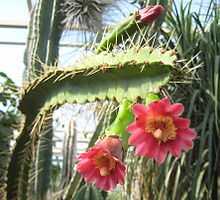
According International Cactaceae Systematics Group, published by Anderson 2001.
Subfamily Cactoideae R. S.Wallace 2001
Tribe Calymmantheae
Plants shrubby or treelike. Stems columnar, segmented, ribbed and winglike, to 8 m high. Areoles large,spines straight, stiff, and whitish. Flowers tubular, white, 11 cm long. Fruits fleshy. Distribution: the Andes of northern Peru. Only one species Calymmanthium substerile.
- synonyms: Diploperianthium F.Ritter (nom. inval.)
Tribe Hylocereeae Buxbaum 1958
Climbing or epiphytic shrubs. Roots adventitious. Stems thin, spination undistinguished. Flowers often nocturnal, sometime very large up to 30 cm diameter. Distribution: tropical forests of Central America.

- synonyms: Aporocactus Lem., Aporocereus Fric & Kreuz. (orth. var.), Heliocereus (A.Berger) Britton & Rose, Lobeira Alexander, Nopalxochia Britton & Rose, Pseudonopalxochia Backeb., Wittia K.Schum., Wittiocactus Rauschert
- Epiphyllum Haw. – climbing cactus
- synonyms: Phyllocactus Link, Phyllocereus Miq.
- Hylocereus (A.Berger) Britton & Rose – nightblooming cactus
- synonyms: Wilmattea Britton & Rose
- Pseudorhipsalis Britton & Rose
- Selenicereus (A.Berger) Britton & Rose – moonlight cactus, nightblooming cereus
- synonyms: Cryptocereus Alexander, Deamia Britton & Rose, Marniera Backeb., Mediocactus Britton & Rose, Strophocactus Britton & Rose, Strophocereus Fric & Kreuz. (orth. var.)
- Weberocereus Britton & Rose
- synonyms: Eccremocactus Britton & Rose, Eccremocereus Fric & Kreuz. (orth. var.), Werckleocereus Britton & Rose
Tribe Cereeae Salm-Dyck 1845
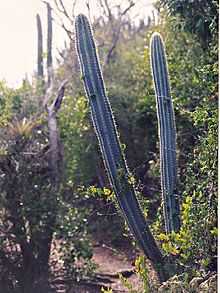
Plants treelike or shrubby, sometimes climbing. Small Arrojadoa or large plants, Cereus up to 15 m high. Stems unsegmented. Terminal or lateral cephalia usually present. Distribution: mostly in eastern South America.
- Arrojadoa Britton & Rose
- synonyms: Pierrebraunia Esteves
- Brasilicereus Backeb.
- synonyms: Mirabella F.Ritter, Piptanthocereus (A.Berger) Riccob., Subpilocereus Backeb.
- Cipocereus F.Ritter
- synonyms: Floribunda F.Ritter
- Coleocephalocereus Backeb.
- synonyms: Buiningia Buxb.
- Micranthocereus Backeb.
- synonyms: Austrocephalocereus Backeb., Siccobaccatus P.J.Braun & Esteves
- Pilosocereus Byles & G. D. Rowley – tree cactus
- synonyms: Pilocereus K.Schum., Pseudopilocereus Buxb.
- Praecereus Buxb.
- Stephanocereus A.Berger
Tribe Trichocereeae Buxbaum 1958
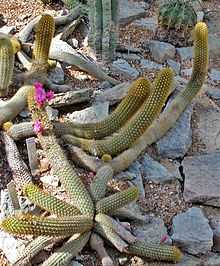
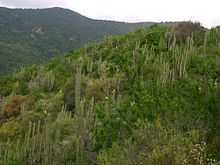

Plants treelike to shrubby, very small (Pygmaeocereus 5 – 10 cm), to large, Echinopsis (synonym Trichocereus) up to 10 m high. Stems normally unsegmented, reproductive areas undifferentiated or differentiated as lateral or terminal cephalia. Flowers usually small, sometime quite large, nocturnal or diurnal, regular or bilaterally symmetrical. Fruits fleshy, berrylike. Distribution: South America, south of the equator.
- Arthrocereus A.Berger
- Brachycereus Britton & Rose
- Cleistocactus Lem.
- synonyms: Akersia Buining, Bolivicereus Cárdenas, , Borzicereus Fric & Kreuz. (orth. var.), Cephalocleistocactus F.Ritter, Cleistocereus Fric & Kreuz. (orth. var.), Clistanthocereus Backeb., Gymnanthocereus Backeb., Hildewintera F.Ritter, Loxanthocereus Backeb., Maritimocereus Akers, Pseudoechinocereus Buining (nom. inval.), Seticereus Backeb., Seticleistocactus Backeb., Winteria F.Ritter, Winterocereus Backeb.
- Echinopsis Zucc. per partes
- synonyms: Chamaecereus Britton & Rose, Helianthocereus Backeb, Setiechinopsis (Backeb.) de Haas, Trichocereus (A.Berger) Riccob.
- Espostoa Britton & Rose
- synonyms: Binghamia Britton & Rose, Pseudoespostoa Backeb., Thrixanthocereus Backeb., Vatricania Backeb.
- Espostoopsis Buxb.
- synonyms: Gerocephalus F.Ritter
- Facheiroa Britton & Rose
- synonyms: Zehntnerella Britton & Rose
- Haageocereus Backeb.
- synonyms: Haageocactus Backeb. (nom. inval.), Lasiocereus F.Ritter, Neobinghamia Backeb., Peruvocereus Akers
- ×Haagespostoa G.D.Rowley
- [= Haageocereus × Espostoa]
- Harrisia Britton – apple cactus
- synonyms: Eriocereus (A.Berger) Riccob., Roseocereus Backeb.
- Lasiocereus F.Ritter – see Haageocereus
- Leocereus Britton & Rose
- Mila Britton & Rose
- Oreocereus (A.Berger) Riccob.
- synonyms: Arequipa Britton & Rose, Arequipiopsis Kreuz. & Buining, Morawetzia Backeb., Submatucana Backeb.
- Pygmaeocereus H.Johnson & Backeb.
- Rauhocereus Backeb.
- Samaipaticereus Cárdenas
- Weberbauerocereus Backeb.
- synonyms: Meyenia Backeb.
- Yungasocereus F.Ritter
Tribe Notocacteae Buxbaum 1958
.jpg)
Plants mostly solitary, Flowers arising from the woolly apices. Distribution: southern part of South America, also driest part of Atacama desert (Eulychnia).
- Austrocactus Britton & Rose
- Eulychnia Phil.
- synonyms: Philippicereus Backeb.
Tribe Browningieae Buxbaum 1966
.jpg)
Plants large, treelike or shrubby. Stems segmented or unsegmented, columnar, ribbed, usually heavily spined. Cephalia not present. Distribution: Andean area of South America and the Galapagos Islands.
- Browningia Cárdenas, Gymnocereus Rauh & Backeb.
- Neoraimondia Britton & Rose
- synonyms: Neocardenasia Backeb.
- Stetsonia Britton & Rose
Tribe Pachycereeae Buxbaum 1958
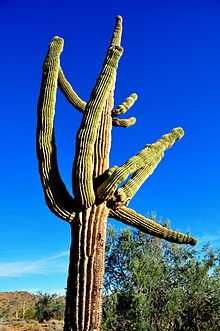
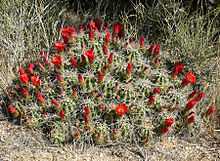
Plants large, treelike or shrubby. Stems unsegmented, columnar, ribbed. Reproductive areas undifferentiated or differentiated into apical or lateral cephalia. Distribution: mainly in Mexico and the southwestern United States but also in the Caribbean, Central America, Columbia, Venezuela.
- Acanthocereus (Engelm. ex A.Berger) Britton & Rose – triangle cactus
- synonyms: Dendrocereus Britton & Rose, Monvillea Britton & Rose
- Bergerocactus Britton & Rose – snake cactus
- synonyms: Bergerocereus Fric & Kreuz. (orth. var.)
- Carnegiea Britton & Rose – saguaro
- Cephalocereus Pfeiff. – old man cactus
- synonyms: Haseltonia Backeb., Neodawsonia Backeb., Pilocereus Lem.
- Corryocactus Britton & Rose
- synonym: Corryocereus Fric & Kreuz. (orth. var.), Erdisia Britton & Rose, Eulychnocactus Backeb. (nom. inval.)
- Dendrocereus Britton & Rose – see Acanthocereus
- Echinocereus Engelm. – hedgehog cactus
- synonyms: Morangaya G.D.Rowley, Wilcoxia Britton & Rose
- Escontria Rose
- Isolatocereus Backeb. – see Stenocereus
- Leptocereus (A.Berger) Britton & Rose
- synonyms: Neoabbottia Britton & Rose
- ×Myrtgerocactus Moran
- [= Myrtillocactus × Bergerocactus]
- Myrtillocactus Console
- synonyms: Myrtillocereus Fric & Kreuz. (orth. var.)
- Neobuxbaumia Backeb.
- synonyms: Pseudomitrocereus Bravo & Buxb., Rooksbya Backeb.
- ×Pacherocactus G.D.Rowley
- [= Pachycereus × Bergerocactus]
- Pachycereus (A.Berger) Britton & Rose
- synonyms: Backebergia Bravo, Lemaireocereus Britton & Rose, Lophocereus (A.Berger) Britton & Rose, Marginatocereus (Backeb.) Backeb., Mitrocereus (Backeb.) Backeb., Pterocereus T.MacDoug. & Miranda
- Peniocereus (A.Berger) Britton & Rose
- synonyms: Cullmannia Distefano, Neoevansia W.T.Marshall, Nyctocereus (A.Berger) Britton & Rose
- Polaskia Backeb.
- synonyms: Chichipia Backeb. (nom. inval.), Heliabravoa Backeb.
- Pseudoacanthocereus F.Ritter
- Stenocereus (A.Berger) Riccob.
- synonyms: Hertrichocereus Backeb., Isolatocereus Backeb., Isolatocereus (Backeb.) Backeb., Machaerocereus Britton & Rose, Marshallocereus Backeb., Neolemaireocereus Backeb., Rathbunia Britton & Rose, Ritterocereus Backeb.
Selected species
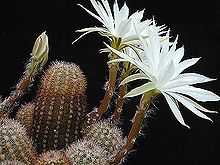

Smallest: Pygmaeocereus, Echinopsis chamaecereus (synonymum Chamaecereus silvestrii), Echinopsis (Seti-Echinopsis) mirabilis, small species of Echinocereus: E. knippelianus, E. laui, E. ledingii, E. pulchellus, E. viridiflorus.
Highest: Carnegia gigantea (18 –20 m, max. 24 m), Neobuxbaumia, Neoraimondia, Pachycereus (synonymum Mitrocereus) (12 – 18 m).
Longest stem: epiphytic Hylocereus undatus (90 m).
Edible fruits: Carnegia, Myrtillocactus geometrizans, Pachycereus pringlei, Pachycereus schottii, Echinocereus: E. fendleri, E. engelmannii and other species, Corryocactus pulquiensis, Selenicereus setaceus, Peniocereus serpentinus, Cereus repandus „cadushi“, Stenocereus: S. fricii, S. griseus, S. queretaroensis, and S. stellatus also cultivated, S. pruinosus and S. thurberi wild.
Pitahaya: red pitahaya Hylocereus undatus, yellow pitahaya H. triangularis. Widely cultivated.
Peniocereus greggii develops a large subterranean root that may be baked, peeled, and eaten.
Cactus fences: Pachycereus marginatus, Cereus repandus.
Firewood: Cereus repandus, Eulychnia sp.
Fishhooks: Neoraimondia arequipensis.
Fishing: Senocereus gummosus contains several toxic triterpenes. Indigenous people in northern Mexico crush the stems of the plant and throw the pieces into the water, stupefying the fish, which are then scooped out of the water by hand.
Hairbrushes: Part of fruits Pachycereus pecten-aboriginum.
Neoraimondia arequipensis is a Peruvian cereus reported to be used as an ingredient in the psychoactive drink called cimora, drunk at various ceremonies and containing material of the San Pedro cactus as well.
References
- ↑ http://www.thefreedictionary.com/cereus
- ↑ Merriam-Webster Dictionary cereus
- ↑ Allied Chambers (1998). The Chambers Dictionary. Allied Publishers. p. 267. ISBN 978-81-86062-25-8. Entry ‘cereus’
- ↑ Umberto Quattrocchi (1999-11-29). CRC World Dictionary of Plant Names. CRC Press. p. 485. ISBN 978-0-8493-2673-8.
- ↑ Merriam-Webster Dictionary torch%20cactus: “any of several columnar cacti of the genus Cereus whose stems were used by No. American Indians for torches.”
- ↑ http://cactiguide.com/article/?article=article22.php
Literature
- Anderson, Edward F.: The Cactus Family, Timber Press, Oregon, 2001. ISBN 0-88192-498-9